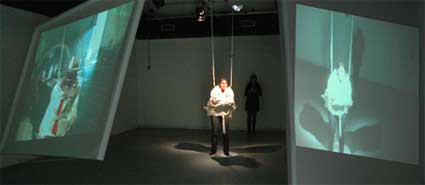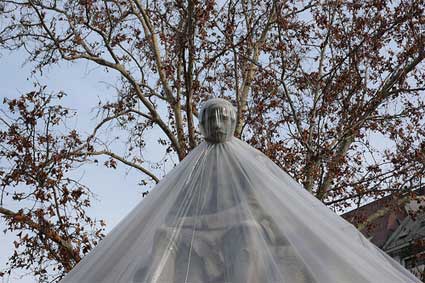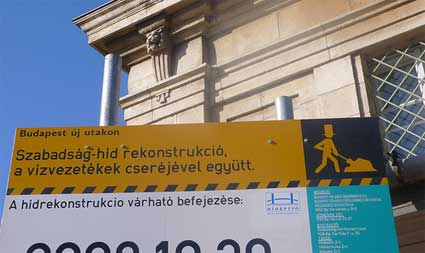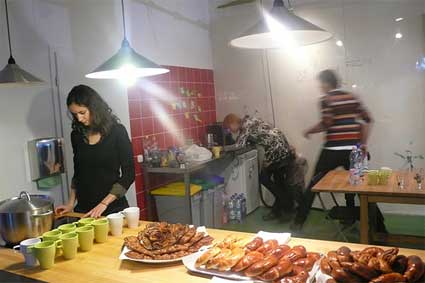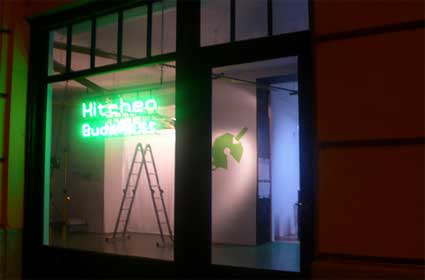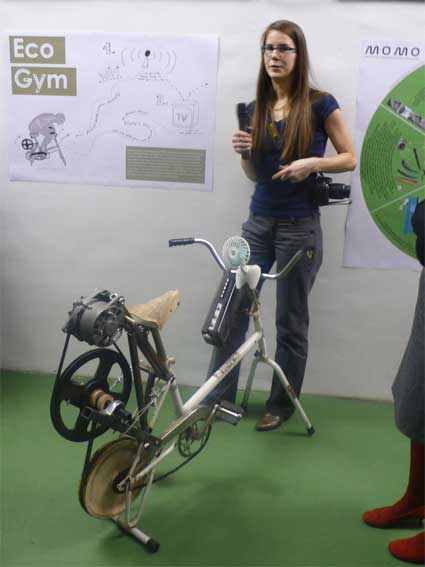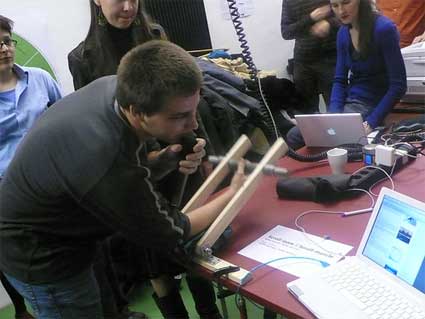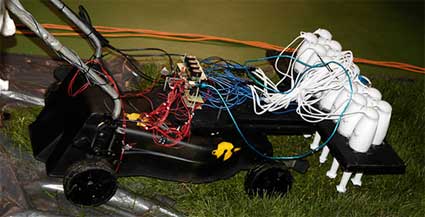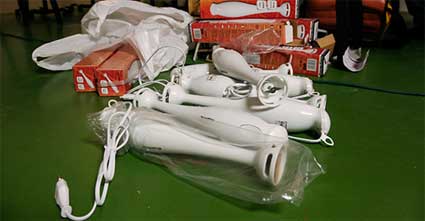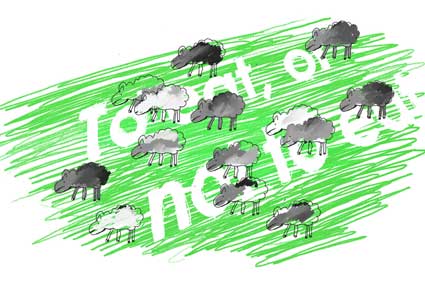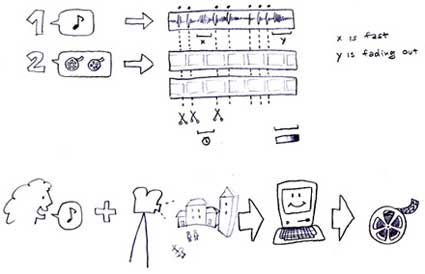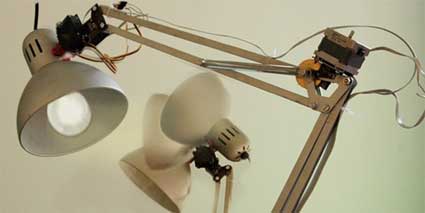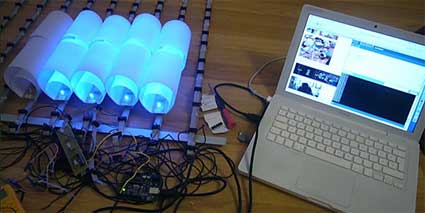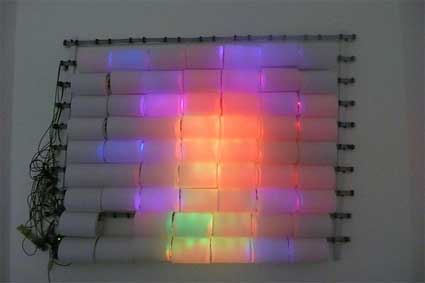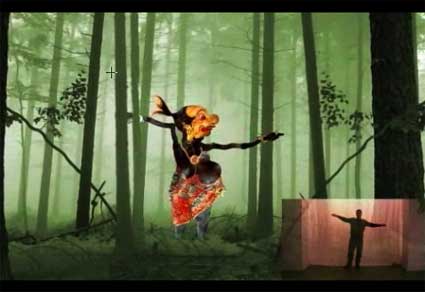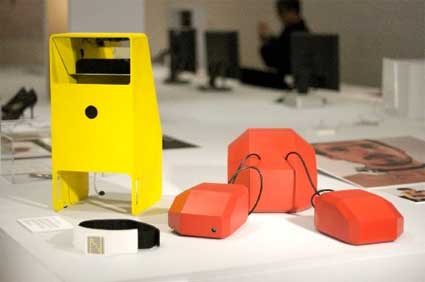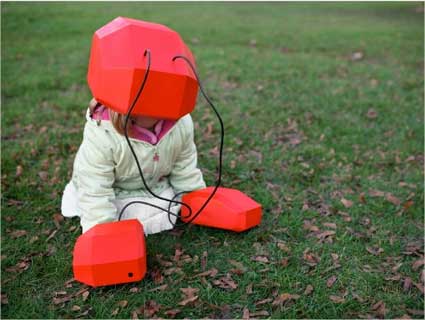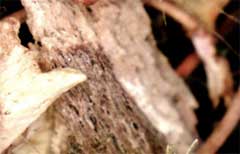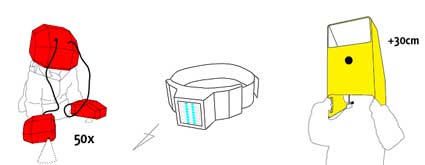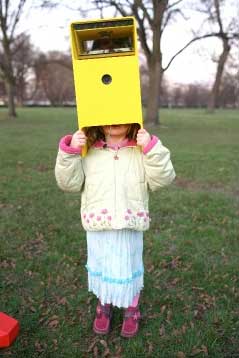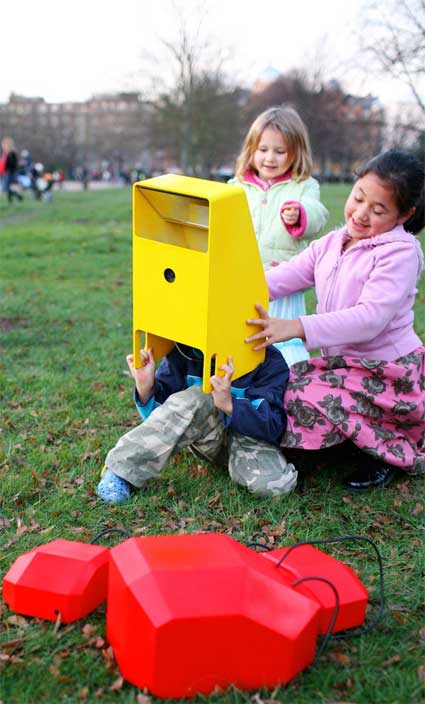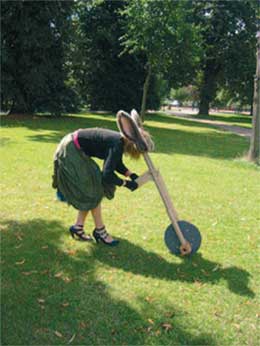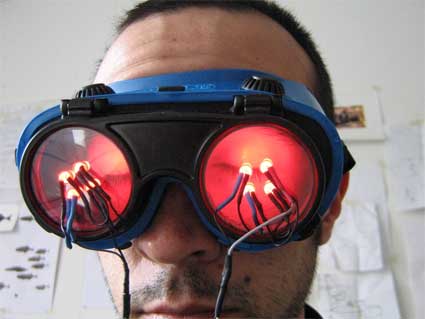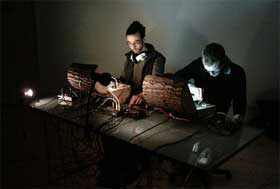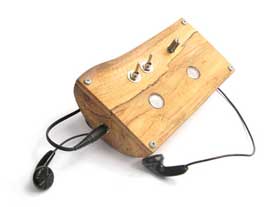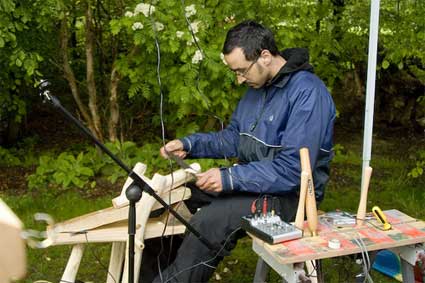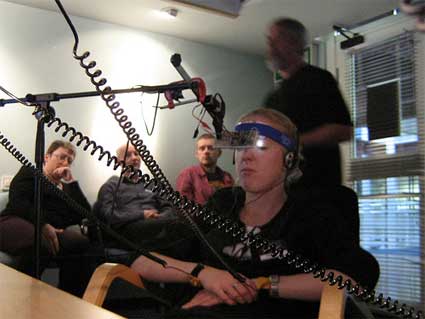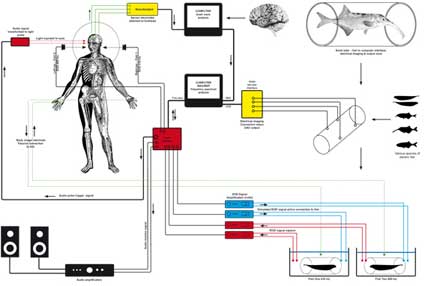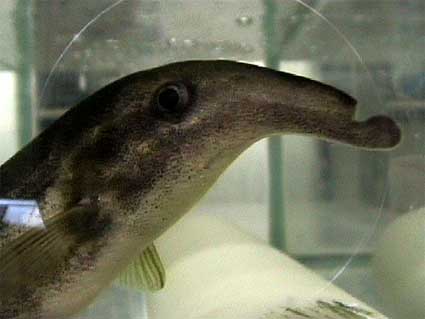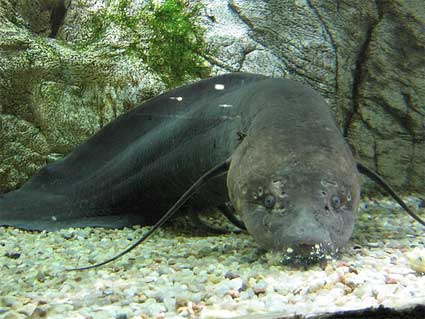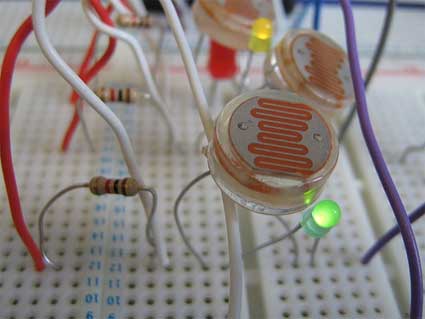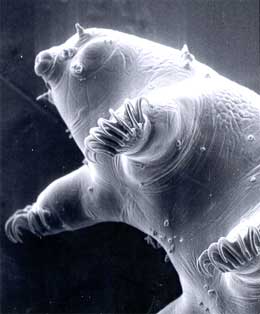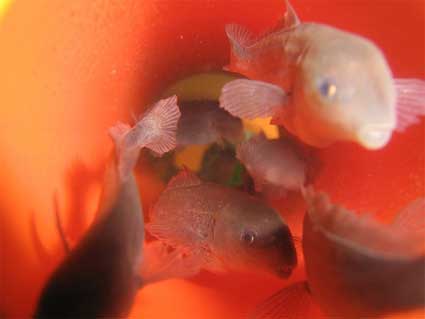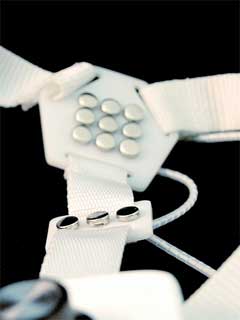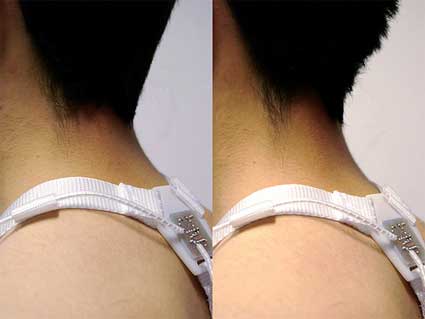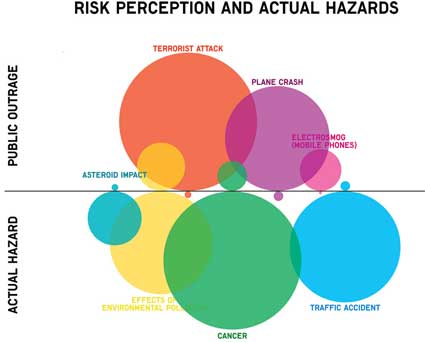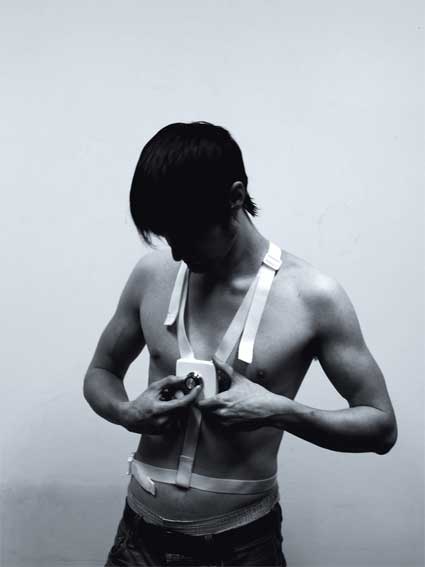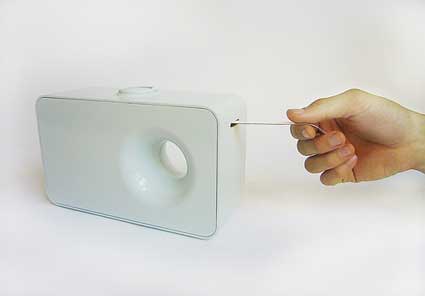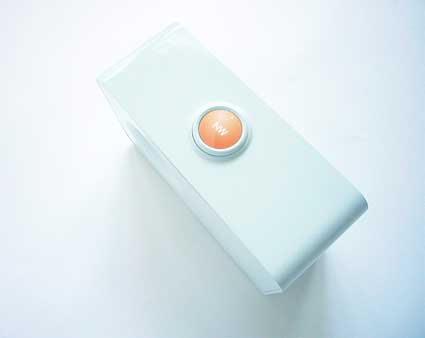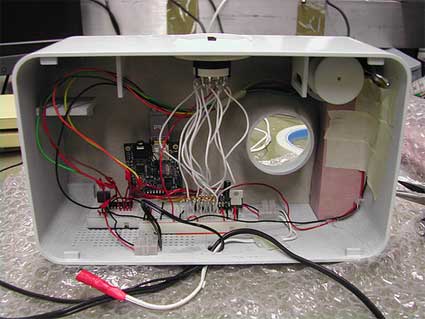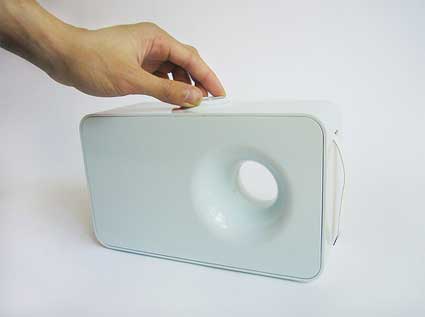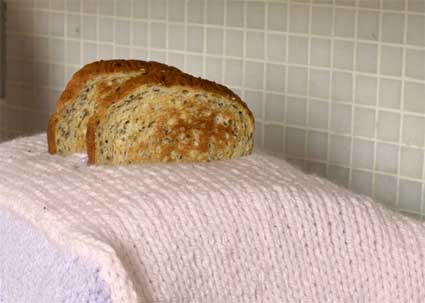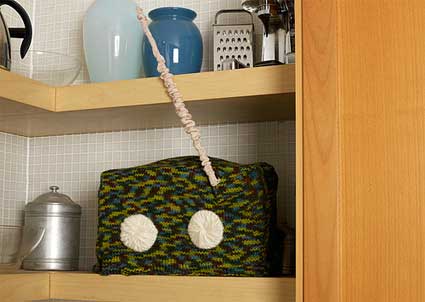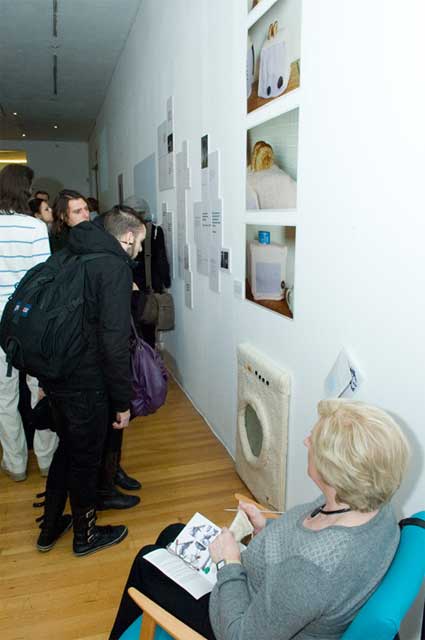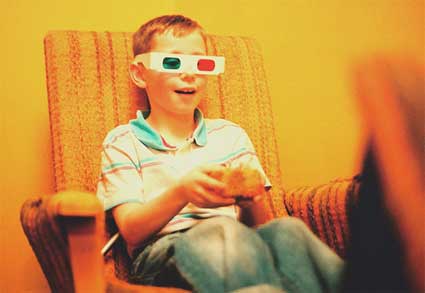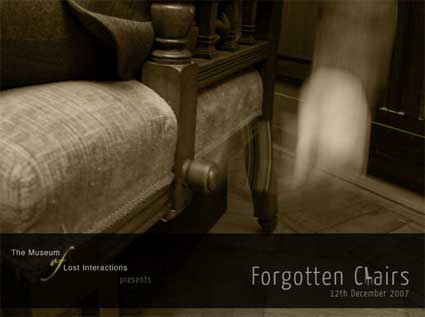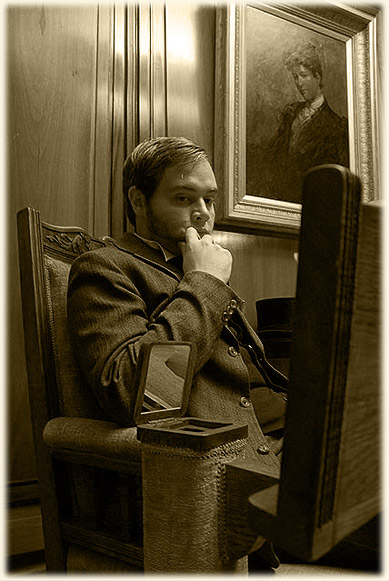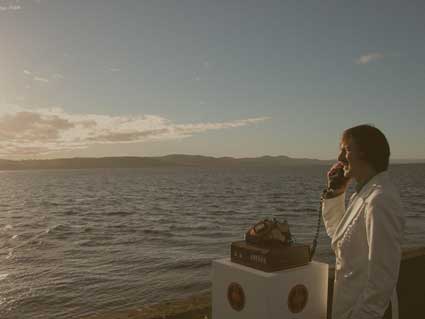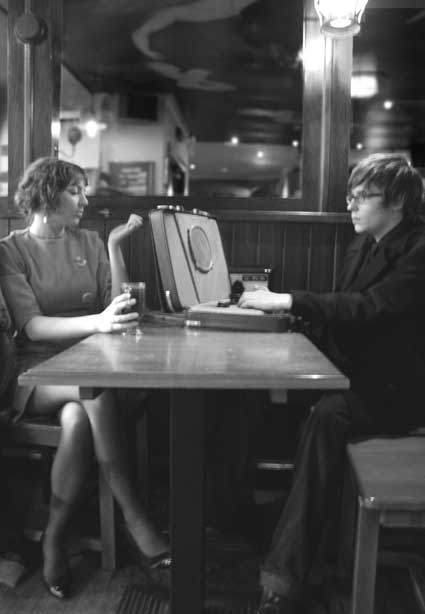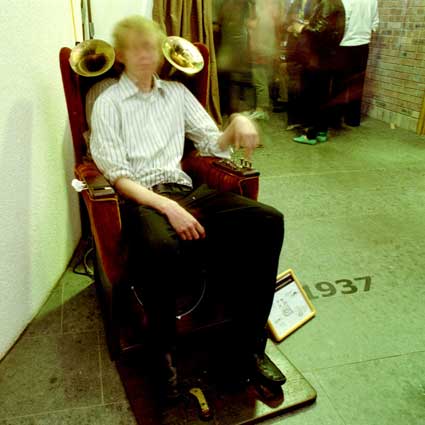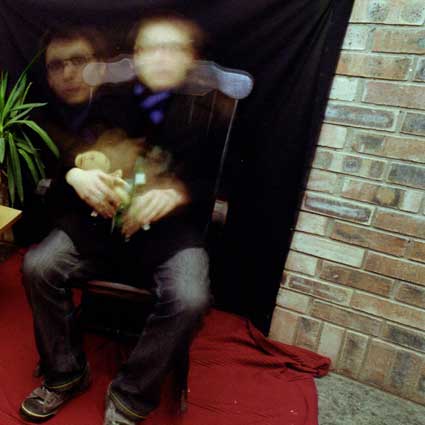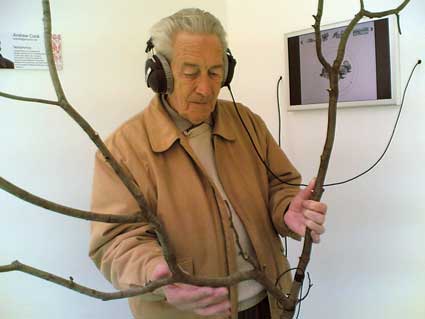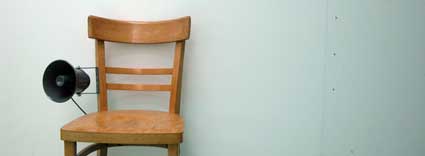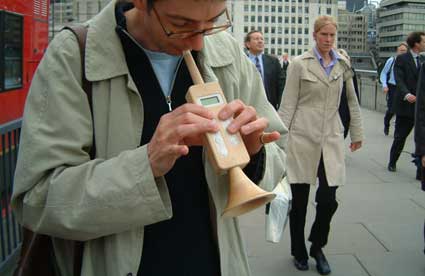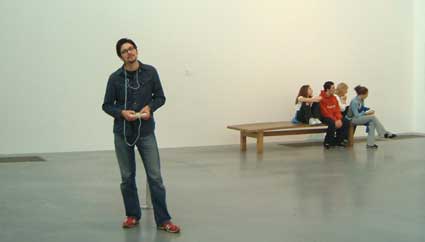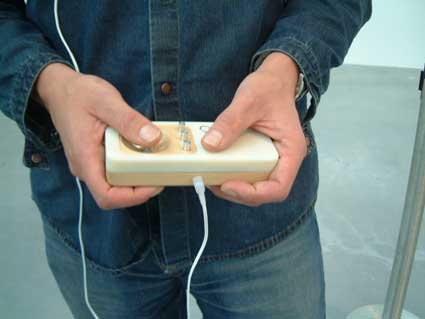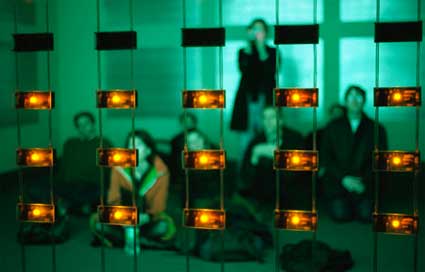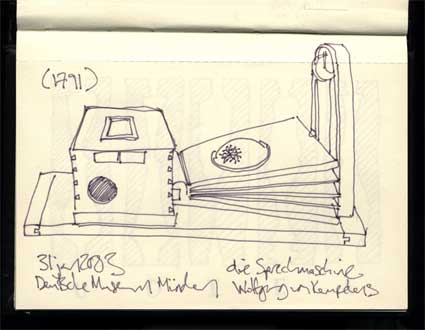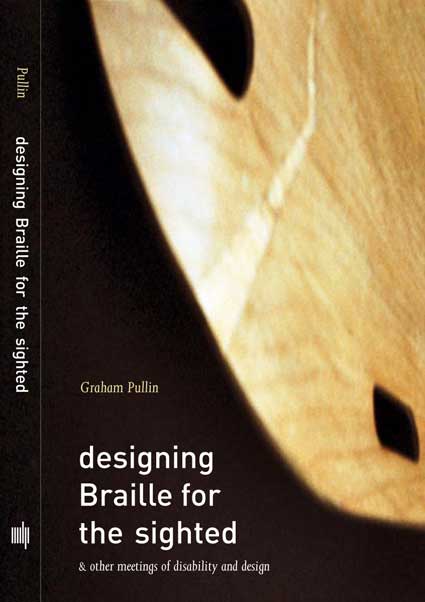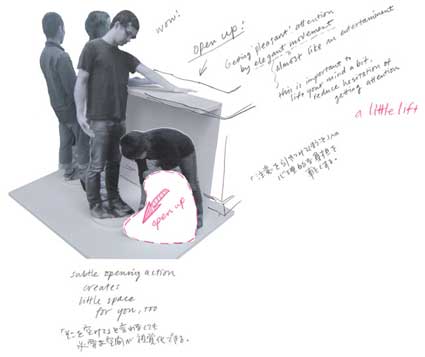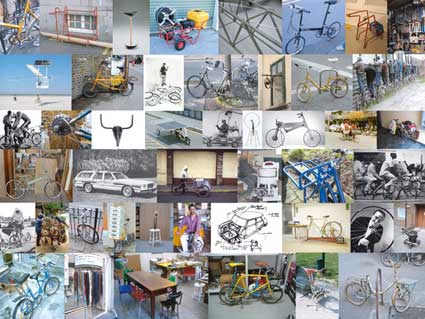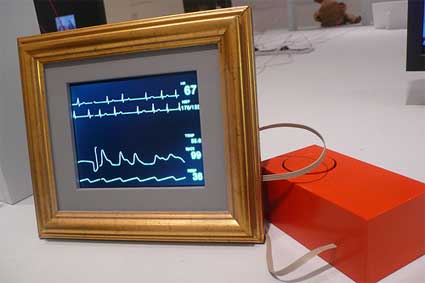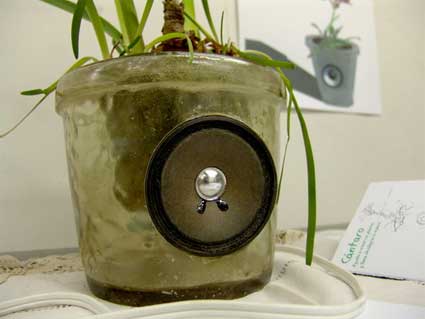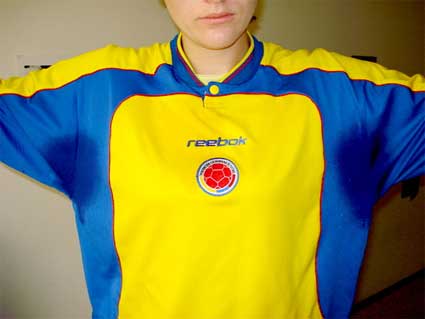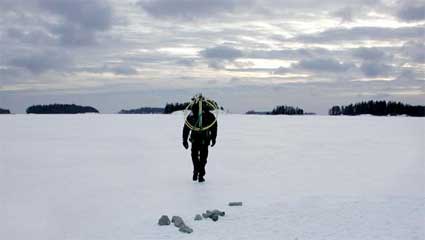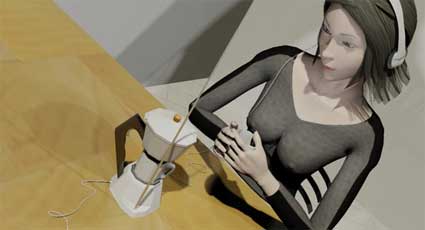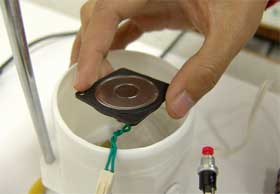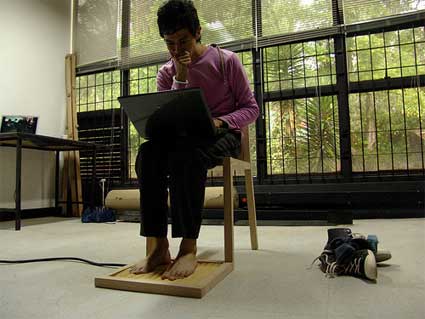New Brave World workshop at iMAL: RFID and art
Posted in: UncategorizedIt’s Monday and although everyone else is probably thanking Easter break for providing them with an opportunity to lay in bed until lunch time, i’ve been up early to give the final touch of my presentation about RFID and art at the RFID workshop that iMAL organizes this week in Brussels as part of its series of New Brave World events. You can follow the episodes of the workshop on its blog.
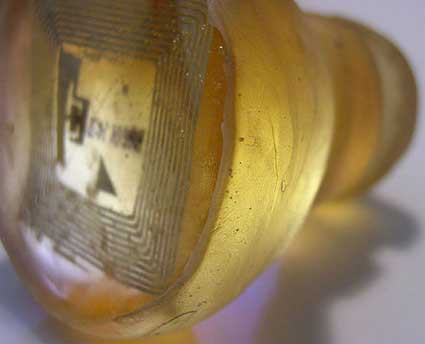
With Hidden Numbers, Meghan Trainor
Just a parenthesis: tomorrow at 8,30 pm Atau Tanaka will give a talk at iMAL about Mobile Music and his other locative media based projects. I wouldn’t miss it if i were in a 200-mile radius.
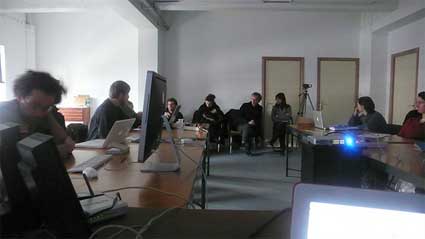
Because rfid had kind of moved away from my radar over the past couple of years, i decided to sex up a bit the preparation of my presentation and share a part of the results with you.
Instead of my usual routine of “let’s see what’s available and what do i think of that?” routine, i interviewed 5 artists (Paula Roush, Doria Fan, Joshua Klein, David Kousemaker and Meghan Trainor) as well as our favourite expert from Tokyo (Konomi Shin’ishi) about their experience with RFID technology. What comes below doesn’t reflect my presentation which was focusing on the ethical and cultural implications of the technology. I used these interviews as background research and thought they might be useful mainly for the workshop participants but also for some readers. So here they are:
1. Doria Fan
Doria Fan was on my victims list because of the sheer gorgeousness of her Medical Alert (RF)ID Bracelet. Technically: a rfid tag has been embedded into the medical ID tag. When the tag is read, the bracelet links the patient to his or her online medical history and automatically places a call to their emergency contact. It would let them know the patient is unwell, and that their records have been accessed.
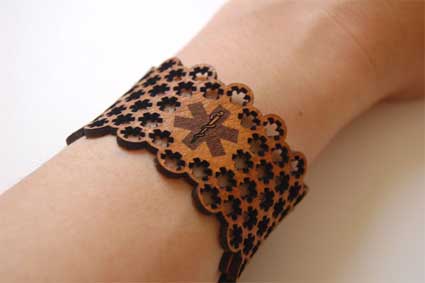
How and why did you start using rfid in your own projects? What made its use necessary?
I started looking at RFID when I was a student at ITP, during the spring of 2006 for my thesis project, which was about object annotation (description). I was interested in how we relate to things, what these artifacts say about us, and how they often serve as proxies for relationships with people. I was taken by the idea that there is a story behind every object. We make and collect physical things — artifacts– that we attach a lot of meaning to. These objects often serve as memory triggers. I was looking at the role of objects (memorabilia, souvenirs, etc.) in storytelling and how digital media can mediate the retelling of memories. I was trying to “embed” personal histories into inanimate objects.
RFID provided a way to link, or embed, information to physical objects. RFID is an identification technology that is fairly discreet and can be embedded in most materials. Tags come in all sizes and shapes, and frequently require no power source, and are fairly indestructible. I considered other (automatic) identification technology, including bar code, semacode optical character readers, retinal scan, etc. I chose to use RFID because it is not a optical/visual identification system. It is physically discreet and less obtrusive. I felt that it was important that the tag didn’t overwhelm the object it was identifying. I didn’t want to put a large bar code on something of (sentimental) value. And, in the case of the bracelets, I didn’t want the technology to overwhelm the aesthetic of the piece of jewelry.
One of the bigger challenges of physical computing and wearables is packaging the circuitry. Size does matter. It’d be hard to view that bracelet in the same way if it were tethered to a lot of wires and a breadboard.
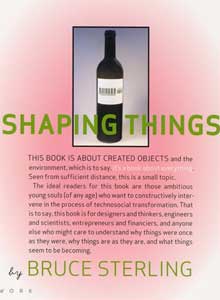 How much of Bruce Sterling’s vision of spimes do you share? Did anything in your experience with RFID confirmed in any way his prophecies of an upcoming spime’d world?
How much of Bruce Sterling’s vision of spimes do you share? Did anything in your experience with RFID confirmed in any way his prophecies of an upcoming spime’d world?
I have read Bruce Sterling’s Shaping Things, and also Julian Bleecker‘s Why Things Matte (PDF)r. I’ll leave it to others to write manifestos. I’m happier when I’m making things. To me, RFID is another technology that is part of my suite of tools and materials to make stuff.
We have the technology to collect and process a lot of data. I’m more interested in the narrative — qualitative than quantitative information. I’m more prone to remember a good story than facts and figures. My personal view is that of all the data we record, the most precious ones are stories. These are impressions — real, reconstructed, or imagined memories — that are a trace of our human experience. Ultimately, the network of things, that they both write about, is connected to a network of people.
There’s a lot of controversy surrounding RFID, are you optimistic or worried about the way it is and it will be used?
I’m not any more optimistic or worried about RFID than any other technology out there. Humans are capable of great kindness and cruelty. That is independent of any technology. There will always be something newer down the line, and there will always be debates about the ethics. For people who are worried about the implications of any technology, the best way to allay your fears is to educate yourself about the technology. Knowledge is power.
Privacy, surveillance — those are real concerns. A lot of people fixate on this for better or worse, when dealing with RFID. I chose not to. When I made the bracelets, my basic premise was that I was going to ignore the issue of privacy altogether, because it gets plenty of attention already. I wanted to deal more with other more pressing issues that are often ignored when designing for healthcare and personal well-being. I was more interested in issues of self-expression and identity, particularly in situations where the user has no choice in wearing a technology, i.e. for medical (assistive technologies be it for a physical or mental disability, etc.), safety, utilitarian reasons, where I find issues of self-identity much more pressing. A person’s health affects not only themselves, but the people around them, so I thought it was important that this be a true networked object. The bracelet provides access to a person’s medical history, and places a phone call to the person’s emergency contact.
This is just one example. There are so many other cool ways RFID, and networked devices, can be used.
What were the challenges and glitches of RFID technology you encountered while using it?
Yes! Figuring out different protocols and getting different things networked can be hard. This is coming from someone who doesn’t derive great pleasure in staring at manuals and code. However, the outcome makes it worthwhile. In moments of frustration, beer or a run help, too.
In of itself, I don’t find RFID that exciting. When it’s connected to a greater network (e.g. a database, the web, other intelligent devices, etc.) , that’s when it can get really interesting. Dealing with the different protocols was the tricky part for me.
Any advice for artists who would like to use RFID in their projects?
Read the manual. Learn to read the manual and the spec sheets, granted they’re not always user-friendly. All the info is there to get you started.
There are a handful of RFID readers that are available and affordable for artists, designers, and students to use for prototyping and proof of concept. There’s a lot info online, too, from folks working on projects, who can write about their work and research in laymen’s terms. I’ve found that people are very generous with their knowledge.
A bit unrelated. these bracelets are gorgeous. do you sell them? and did you do the design yourself?
Thank you. No, I don’t think the question is “unrelated” at all.
Yes, I did design the bracelets. I think the design of the bracelet is very relevant and integral part of the project, even more so than the (RFID) technology behind it. The typical person engaging with a product/project is more interested in the experience, than the nuts and bolts behind it. Part of reason medical ID bracelets, and other “utilitarian” things out there are underused, is because they don’t address some of the basic needs, such as self-expression and identity, of the person its designed for. Emotional, visceral, psychological needs are not to be underestimated in the success of a product or experience. While making it, I was just as interested in design of the bracelet than the technology (RFID, Asterisk) behind it. One of my requirements for this project is that bracelets had to be attractive.
No, currently, they aren’t for sale, although I have received a few inquiries, which is encouraging. I’m guessing that the people inquiring about the bracelet are drawn more to the design of it than the technology.
Thanks Doria!
More info on the bracelets on Doria’s website and on the course page.
2. David Kousemaker, Blendid
Next is David Kousemaker from Blendid.
He was one of the developers of iTea, an uncanny tea table that spilled “facts” of your own life on its surface during the Picnic conference in Amsterdam last September.
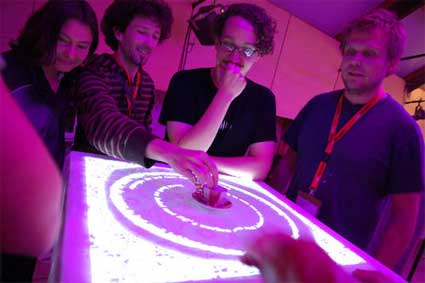
By dropping your conference Tag in an old porcelain tea cup, the system will search the internet for data about you. The information will start to appear on a flat projection underneath the cup. Sentences will appear as ripples and move out towards the edges of the center.
The system searches the Picnic social network for information about this person, it will also do a google search to retrieve even more “facts” on him/her. Together, these facts will blend and show the (hopefully) untrue image that person has been given by the community on the net. In fact, it is even possible to use information appearing on social networks like Flickr, hyves and hotmail. Be aware and beware of the global opinion about you!
Video:
I was truly charmed by iTea when i saw it last year at Picnic in Amsterdam. I was also amazed at how fast you managed to imagine it, build it and have it working. Behind its playfulness there is an element of critique and awareness (i think!) Do you think that we should be more afraid than happy about new technologies and about RFID in particular?
Although I recognize its double face, on the whole I’m personally quite optimistic about technology’s ability to improve our lives. Many of the concepts that inspire the fierce debate on RFID and privacy are part of scenarios we live through every day already. Most of us are probably aware the huge surveillance capabilities of mobile phone networks, yet few of us dare to be without our handsets. Having this privacy debate late might be better than not having it at all. I’m just not sure if narrowing the discourse to such a specific technology is that helpful.
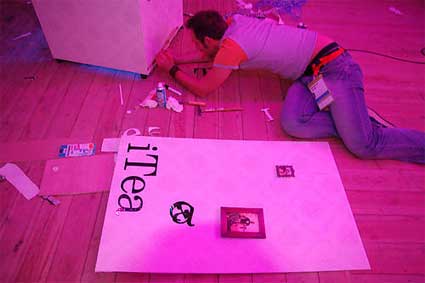
What was the biggest challenge when building iTea and how did you overcome it?
The iTea was build with a group of designers/artists who initially didn’t really know each other very well. It took us some time to figure out what direction we wanted to work in. On a 3 day project the clock is obviously one of the biggest possible challenges, but I think coming up with a concept that made use of our individual talents was the trickiest task.
Any other projects where you used RFID with success?
In the last year or 2, we’ve used RFID in a several different Blendid projects. We developed an interactive media playing straitjacket for 2 dutch artists (Straitjacket Embrace) with RFID tags and readers build in to trigger different audio and video samples. We also used RFID in Wixel Play, a very physical computer game we created for the Cinekid festival.
More generally, what does RFID bring to a project that you can’t achieve with any other technology?
Many people seem to think RFID systems can tell us the exact locations of particular tags. This is only partly true as(for the moment) RFID systems can only tell us if a particular tag is in close proximity of the reader (about 10 cm). We have used these boolean proximity signals as triggers for events in our games or installations. Being able to use objects with hidden tags or readers as a direct interface brings something both obvious and magical to our designs.
Thanks David!
3. Josh Klein
Next, i asked Joshua Klein (he of the Vending Machine for Crows) to tell us something about OwnYourStuff. Joshua and his wife made a site that enabled them to track everything they own. “The basic premise is that having both quantitative and qualitative metadata about your things allows you to more closely examine your relationship to those things. It’s been our experience that this maximizes the quality and lowers the quantity of your stuff (and thus reduces the time, expense, and attention that stuff demands.) Right now this seems daunting as we’ve had to enter in everything by hand, but as RFID technology gets more pervasive this sort of examination is going to become available to everyone – whether we like it or not.”
I read on the website of Own Your Stuff that you’ve been working on this project for several years. Was RFID part of the project right from the start? How and why did you start using it for OYS?
OYS isn’t yet using RFID as we’re working with several major manufacturers to find the best resource. We’re really interested in using as open a hardware platform as possible so to analysis and code that we develop can be available to everyone. That means being able to read a wide range of tags, specifically.
Your idea was inspired by Bruce’s spimes. How much of his vision do you share? Did anything in your experience with RFID confirmed in any way his prophecies of an upcoming spime’d world?
Yes and no. For example, I think that we’ll see a huge rise in RFID’d goods, but I don’t know that this will cause them to automatically start staffing themselves in our home. For example, a huge proportion of the items you buy are boxed, and the boxes are tagged with RFID. The boxes go out in the trash, but the goods stay behind.
This means that different classes of items are likely to be readable in the home, depending on the market, packaging, manufacturing, as well as local and individual trends. So while I think Bruce has a very solid handle on things the transition to the services he describes is going to be scattershot and erratic. Which is pretty much in line with what he describes, really. 🙂
There’s a lot of controversy surrounding RFID, are you optimistic or worried about the way it is and will be used?
Certainly, although I’m pretty concerned about the lack of privacy concerns that exist now. In the US polls indicate that people are happy to give up freedoms in exchange for perceived security – hence the current state of airport theater. I’d rather worry about my online transactions being recorded before I worry about someone being able to tell how many cans of peaches I bought.
Since you’ve been working with RFID for several years, what were the challenges and glitches of the technologies you encountered while using it?
As I understand it the biggest problems with RFID are range and noise – specifically how many tags you can read at once. Conceptually RFID is very clean, but the reality of it is that, like any energy signal, it’s prone to being disrupted by other signals, by proximity, by the number of items in a certain configuration or size of area, etc. We like to think that we could just aim an RFID detector at a room and be told what and where every item is, but it’s hard to do that really reliably.
That’s a big part of the reason why our own design is using doorways to limit the detection area.
Thanks Josh!
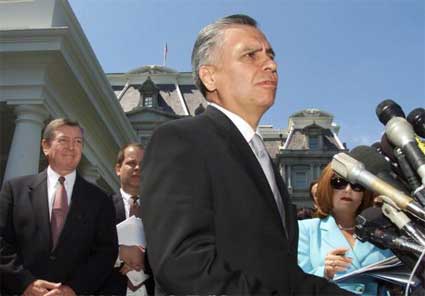
Rafael Macedo de la Concha, the first RFID’d attorney general
4. Meghan Trainor
Meghan Trainor was on the top of my list of artists to interviewed because she’s been one of the first to investigate artistic uses of RFID.
How and why did you start using rfid in your own projects?
In 2004 I was halfway through getting my Master’s degree from NYU’s Interactive Telecommunications Program (ITP.). I had a background in traditional visual art, but had come to ITP to explore technology as a medium, and had become increasingly interested in the aesthetics of ubiquitous computing. Computational media was interesting to me, but I wanted my audience to experience it outside of the standard computer screen keyboard interface. Tom Igoe‘s Physical Computing & Networked Objects classes had a huge impact in the evolution of these ideas. So in the summer of 2004 when I read Dumbing Down Smart Objects, an article by Bruce Sterling about RFID, I caught the RFID bug. He described a landscape that was going to allow data to seep into the physical word that really spoke to where my head was at already, plus as a bonus you could inject these things. What was different about RFID, as compared to other methods of bringing technology into physical objects, was that the cost of a single tag was exponentially less than using microprocessors or cellphones or bluetooth, so rather than a few devices making up a system, I could have dozens, if not hundreds of “dumb objects” within a system.
How much of Bruce’s vision of spimes do you share? Did anything in your experience with RFID confirmed in any way his prophecies of an upcoming spime’d world?
Oh, I was tremendously excited by Bruce’s vision, the idea the objects can become protagonists in a documented process was a key piece of poetry that drove my work. I think he did, and does, do a really good job of standing just past the present an imagining reasonably plausible outcomes. That’s what makes a good science fiction author, right? And why this is important is that these changes may come quite soon, so how do we make decisions without getting to a place where we, as individuals, can sort of “feel” what the future implications of things are?
From a practical standpoint I’ve been a little frustrated at how hard it is to actually build even a small scale model of that spime idea. There was a lot more to it than just RFID, I mean I’m waiting for those household 3D printers to become a reality, at which point I fully expect to be sending little RFID embedded sculptures through the interweb to people on the other side of the country…I am ready!
I think one thing I don’t focus on myself, but is an interesting part of Bruce’s concept, is the potentially positive impact of RFID tags on the environment, I feel like that gets lost sometimes. I know there are a lot of privacy concerns, and I feel that some of those are quite valid and important to hold companies to task on. But the idea of sifting through dump and simply returning that crap to the manufacturer is a powerful idea. “Ok manufacturers, here’s your crap back, now we have a playground.” The consumer isn’t the end of the product life cycle, he’s just a renter.
It’s a little early to weigh in on a prophecy coming true or not, but I will say this. My conception of RFID, how it works, what it’s capable of, changed radically once I started actually working with it. Based on my early research I was envisioning a scenario in which objects could be tracked in space, sort of like an inverted form of virtual reality, where a computer is mapping the physical world into a model it could understand. But this notion of “tracking” in the sense of say, GPS or something like that, is not really how RFID functions. RFID tracking is really most like the way UPS tracks your packages with a bar code. It can tell you when an object passed near a specific place, like a toll booth or a checkout counter. In the UPS scenario you know your parcel left the warehouse, but you won’t know where it is again until it hits Tulsa. Now with more powerful systems and other tools you can start to make specific spaces that function like the GPS tracking model, but this is pretty technological intensive, and by that I mean expensive. That also doesn’t mimic how it’s used in its natural environment. RFID in the wild is used as a momentary switch; you unlock a door with a keycard, you buy groceries with a keyfob, you pay for your toll with EZ Pass. So for me as an artist, I also use RFID this way, although my work generally involves different sets of objects that impact each other’s behaviors. At the end of the day I’m not so much interested in RFID itself, but rather, how to build environments in which computational capabilities are experienced in a new and tangible way. Right now I’m doing research into creating objects using brainwaves and 3D printers, which doesn’t involve RFID at all, but does involve new and tangible ways of interacting with, or more accurately in this scenario, creating objects.
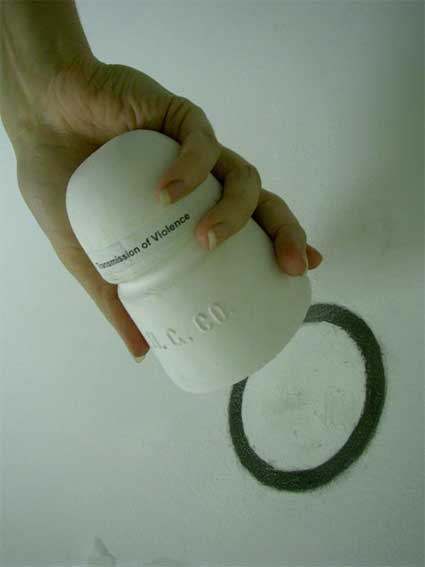
Transmission at NERD, image courtesy of Meghan Trainor
There’s a lot of controversy surrounding RFID, are you optimistic or worried about the way it is and it will be used?
I would say I’m less worried than that average human and that that is primarily a result of working with this technology for years. While I wouldn’t put my concern at zero, I would say there are a lot of other things I worry about first, like our government’s investigation of citizen phone records, torture at Guantanamo, my credit card data, people posting pictures of me on Flickr without me knowing about it.
I think there are really bad design choices that can be made with RFID and those design choices can lead to problematic scenarios. Writing actual sensitive data onto the tags is just stupid, to which I say…don’t. If you look at the design changes to the US Passport and ID cards you can see the transition from a bad design, in which actual personal data was to be stored on the RFID tags, to current designs in which the RFID tag is a key to remotely stored data, which is how most function. The RFID tag in my arm doesn’t have anything on it but a long number, so you can skim my arm all you want but it just doesn’t tell you anything. Well if you stored the number, it could tell you I’m in close proximity to you, but you probably could smell me at that point, or I could wear a shirt with metal threads in it to block the signal.
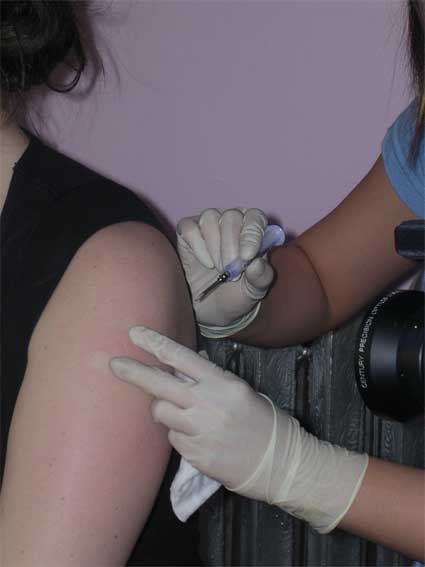
So there are quite a few different concerns about RFID, there are consumer concerns about privacy, there are security concerns about hackable keycards, there are human rights concerns about injected tags, the list goes on. But if your concern is privacy, I think there are a lot of other technologies out there that just do a much better job at tracking you than the tag in your jeans, so yeah if the systems get more robust and/or ubiquitous and the tags get smaller and/or cheaper negative scenarios could come to pass. But today, right now at this very moment, the police can locate my cellphone using triangulation, which is just about the same as locating me.
I think part of the concern comes from it being a novel way of transmitting data, although this technology has been around for a long time and radio itself is hardly new. But RFID can seem sort of magical, and it’s hard to understand what data is actually being sent and how far that transmission range is, and because there are so many different kinds of tags and use scenarios it gets complex. A passport broadcasting your social security is different than a library book spitting out a random number that only identifies the book as number 5 of the 10 copies of Moby Dick in circulation to the library system.
I think another thing we all have to just sit down and think about it that this is just the tip of the iceberg as far as emerging technologies and the ramifications of ubiquitous computing. We do that by thinking about it and writing about it and at some point we have to start building little scale models of the future and testing our hypotheses.
Since you’ve been working with RFID for several years, what were the challenges and glitches of the technologies you encountered while using it?
Initially my greatest hurdle was how do I design for readers that can only scan at a few inches? How do I create a scenario where the audience will trigger the objects embedded with tags? And how do I create the objects so that they can be read no matter how they are orientated? This immediately informed a very specific size range for my objects.
The other challenge is to create a scenario that is rich enough to help my audience envision a world of objects that have changing properties in both the digital and the physical world, but isn’t so muddled that everything just seems random. In performance this is easier because I control the interaction and can slowly build up the audiences understanding of what they are observing. In interactive scenarios I have no way of determining what my audience will do or how long they will participate, so every possible interaction has to be accounted for; the interaction needs to be immediately felt or understood, but also has to be rich enough to be explored over time. In the beginning I was trying to create a networked “Internet of Things,” but for the user, just getting used to the idea that an objects was a trigger that could change properties was about the limit of new information, so I began to focus on just that aspect of my original ideas.
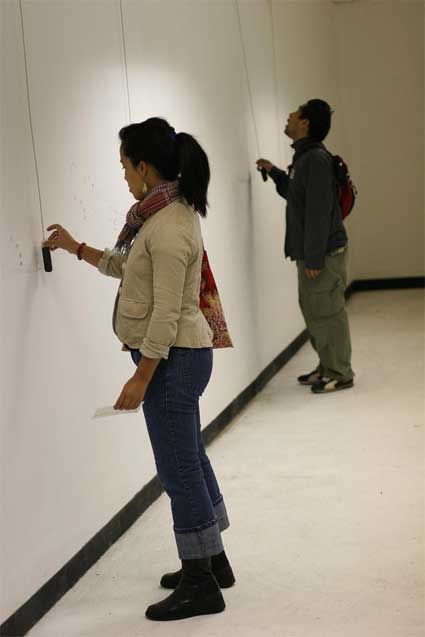
Transmission at NERD, image courtesy of Meghan Trainor
Any advice for artists who would like to use RFID in their projects?
Design your projects after you’ve played around with an actual RFID system first. Gaining a real concrete grasp on what RFID can and cannot do can have a huge impact on the design of your project. Sometimes RFID isn’t actually the right technology for your goal, maybe you need video tracking equipment or you need to combine RFID with something else to get the desired effect. Get a reader, get some tags, build a mock-up and test it. Also I would encourage user testing too once you’ve got something built, audiences can be great at showing you what is actually being communicated and challenging your assumptions. Performance with RFID can be easier, because you’ve determined what happens when, but in an interactive scenario you’ve got to design for every possible interaction. How does the user know what to do? What should the user make of this interaction? Is there a “right” way to interact? One of the most challenging things is that once you cross over into art that is interactive, whether it’s made with RFID or not, art that can be touched, is that people will test it, and that can often mean they will break it. So either you have to design with this in mind, control the interaction closely or surrender to the experience.
Thanks Meghan!
5. Paula Roush
The London-based media artist ih is probably the first who have explored the sonic properties of RFID.
From the project page: “Arphield Recordings is a project documenting impromptu arphid sound performances produced by people scanning their oysters cards in the daily routine of access control to the London tube stations.
The methodology of field recordings (documentation of site-specific soundscapes through audio recording equipment) is, in this case, focused on the sampling of sounds produced by the use of arphid (rfid) technology (cards and readers) complemented by digital processing involving sampling and synthesis from the source, speculating on the ad infinitum convergence of arphid tags and readers into an endless symphony of sound surveillance and compliance.
The project started with the idea for an arphid mob, inviting friends to join me at a designated tube station for a semi-coreographed sound jam using our oyster cards. The main question was ‘when and where’ as a major impediment would always be the heavy security at all the gates. It was decided I would do some observation and this would eventually indicate the best timing and location for our arphid mob. Observing the familiar tube’s access control gates, initially with no equipment and later with a camcorder, I realised that people were already engaging in impromptu sound performances. My documentation led me to discern varied patterns and even participatory scores, with mass arphid soundscapes punctuated by silences, glitches and cracks in the system, all warped up in a circadian rhythm of work-rush hours.
The first arphield recordings – documenting the impromptu sound performance of people moving through the London tube access control gates were done in Brixton, Kings Cross and Caledonian Road tube stations during march 2006 for the TAGGED one day event at SPACE Media Arts (NodeLondon March 2006), when cds with the tracks and locational tags were distributed.
The second arphield recordings- the stockwell sound/jam memorial happened on Saturday 10th of June 2006 when people in london were invited to gather in the Stockwell tube station and scan their oyster card for 30second sync periods accompanied by a podcast of pre-recorded oyster beep tracks.
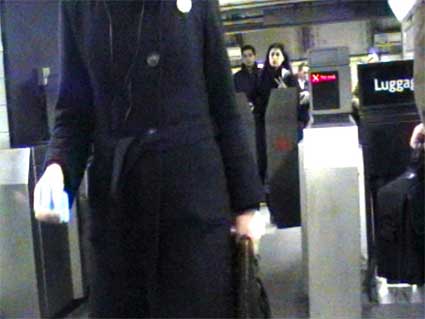
Image courtesy of Paula Roush
The project remains open to contributions. One way of doing this is downloading the arphield recordings and visiting the station gates with the sounds on a portable music player to experience a mix of live and prerecorded oyster beeps.
Another way of participating is by contributing arphield recordings from a tube station access control gate. You can do this by opening an odeo.com account and uploading your recordings , tagging them as arphieldRecording followed by the number unique to your oyster card (as in arphieldRecordings-0503266130-03)”
I sent Paula my questions and she almost immediately emailed me an interview she did for Armin Medosch in the framework of the Tagged exhibition by Space Media Arts (btw, don’t miss his text about RFID: The Spychip Under Your Skin). She authorized me to reproduce it below:
Why did you decide to propose an RFID project? What was your specific motivation in this case?
Arphield Recodings was conceived as a probe into the practice of sousveillance and a more general understanding of the the arphid surveillance/equiveillance of public space and transport. It also foregrounds itself into the field of networked performance and possible notions of community, interaction, and connectedness among participants.
The emerging field of personal sousveillance – the capture, processing, storage, retrieval, and transmission of an activity from the perspective of a participant in the activity (i.e. personal experience capture) using camera phones, and wearables has been mainly focused on the visual. See the dominance of weblogs as photo- and video-blogs. Surveillance studies as well have given a proeminence to the visual. However, “The history of surveillance is as much about a sound history as a history of vision” / “we need a sound history of surveillance” / “the polyphony of sounds increasingly regulates and is regulated by us” as Michael Bull and Les Black write in the intro to the Auditory culture reader (2003).
‘eavesdropping, censorship, recording, and surveillance are weapons of power’ writes Jacques Attali.
‘The technology of listening is on, ordering, transmitting, and recording noise is at the heart of this appparatus…who among us is free of the feeling that this process, taken to an extreme, is turning the modern state into a gigantic, monopolising noise emitter, and at the same time, a generalised eavesdropping device (Attali, 1985)
Heritage: back to the initiator of urban field recordings Pierre Shaeffer‘s Etudes aux chemins de fer (1948), first example of musique concrete he also employed a variety of manipulation techniques because for him the sounds remained too recognisable which led him to define it as sound-works but eventually reject as music.
Video:
Into the present where collage and field recordings in the electronic age include Dialtones (A Telesymphony) (Golan Levin), data noise (Ryoji Ikeda).
In ‘sync or swarm’ -improvising music in a complex age, David Borgo (2005) positions music-sound as an excellent site for the study of sync in performances and in the dynamics that shape a musical community.
‘coordinated rhytmic activity ‘ crucial to social life /”muscular unison” collective bonding are as much at at play in improvised musicking as when people are moving through the arphid gates, sharing a sonic experience there is some sort of group interactional synchronicity/ observing one can see an underlying modulation between sync and swarm, order and chaos mediated by the network.
Michael Bull / Les Back / Jean-Paul Thibauld have all described the ordinary experience of moving through the city with mobile sound devices: walkmans, car radios, ipods and how new sonic territories are created in the course of this journeys. Similarly. The experience of public space is transformed as users move through with their oyster cards / the daily regulation of city walking/journeying through the beeping of several electronic devices as oyster card users (oycus) engage with sound-technology use / jean-paul thibaud in The sonic composition of the city (The Auditory Reader) uses te term ‘sonic bridge’ to refer to the way music links the inside and outside of social experience into a seamless web
What do you think about RFID in terms of its cultural-political significance?
The oyster card has an added layer due to the arphid’s identity features the processes involved include:
1-the registration of the card with one’s id and a product identifier ( unlike the barcode the unique id number inserts one into a traceable network that can map you in space/time >spime). Id technologies, such as passports, national id cards, have been designed to facilitate identification by binding identity to the body, by associating w/ other identifiers such as the name, address, signature, but crucially arphids bind the body to a unique identification number, that will be associated with a database allowing for all sorts of correlations between data and other personal/social identifiers
2- the second step is connected to topophonic knots (Thibauld’s term), the interference point between media listening (in this case sound-producing) and architectural space/ is the one of access which leads us to think of the traveling space as one of doors (bus), gates (tube/trains), with the transition from the motion of walking into the one of being transported; the gates of the tube station or the readers inside the bus are sonic doors/or outposts intermediary between two ways of traveling the city in the case of the tube even more accentuated by the shift in verticality from the underground space into the street level.
Also the space where regulation is more visible and the identification of the body becomes audible and thus public and de/re/territorialised.
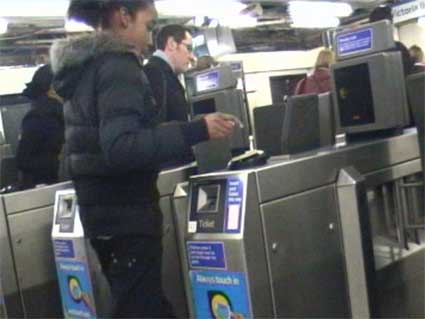
Image courtesy of Paula Roush
How does this (your thoughts about RFID) fit into a bigger picture about a digital and network culture? For instance do you think we experience a real paradigm change from industrial to information age? What are the key aspects of this change? Where are highly developed countries heading?
Towards a network of things. For me Shaping Things (2005) is an inteseting speculation into the way our relationships with the objects in our environment is changing. For the first time we start to be surrounded by objects that have an identity which can be associated with our own identity and that being traceable in space and time spread that traceability to its users.
Bruce Sterling dates this techno-social change to the dawn of spimes to 2004 when the United States Department of Defense demanded that its suppliers attach arphids to military supplies. You could add to that the WalMart demand for its suppliers to add arphids to the commodities in order to standardise stock inventory. The full implementation of EAN_UCC (which might take from one to three decades) will bring a technosocial change which we are are already experiencing.
Arphid became almost synonymous with the internet of things and with ubiquitous computing, with its tendencies to use centralised proprietary systems, sharing information between authoritarian structures of commerce, policing and control but creating a form of segregation by excluding the surveilled from access to this data.
What is the role of artists working with ‘new media’ vis-a-vis the ICT industry and commercial creative industries? I would like you to answer this question in a personal way. What is ‘your mission’ as an artist working in this environment?
The most interesting position one can take now is to expand or enlarge on current studies of surveillance. On one hand, metaphors that describe our current state of surveillance as panopticon are now well established and there is also an acknowledgment that people are starting to use the panopticon tools for playful, entertainment and tactical purposes. On the other hand, unlike surveillance that isolates and dis-connects, there is a feeling that today’s personal sousveillance technologies like camera phones and weblogs might help to connect and build networks or a sense of community.
The work of Humberto Moran addressing the role of free open source software and privacy-friendly technologies as a way of maximising the social and environmental benefits of RFID is also relevant.
Crucially, equiveillance -the balance between surveillance and sousveillance- which allows the individual to construct their own case from evidence they gather themselves, rather than being subjected to surveillance data that could possibly incriminate them, remains the more viable road.
For example, one of the most disputed events following the 7/7 attack, following the murder of Jean Charles Menezes in the Stockwell tube station is the narrative surrounding the use of oyster card by Jean Charles and whether he jumped over the ticket barrier running down the escalator to jump onto the train. This was registered in the post-mortem report but later the police briefed the family that he had actually used the travel card to pass throught. According to the leaked IPCC documents, Menezes passed through the barrier normally using his pre-paid Oyster card. Police initially refused to release CCTV footage while the IPCC investigation was ongoing, even to the family. It had been suggested that the man reported by eyewitnesses as jumping over the barrier, may have been one of the police officers in pursuit. Even more chilling than this slippage, is the fact that such technology is already in place that allows for the tracing of public transport users throughout the city as a centralised database to which its subjects cannot themselves have access.
In March 2006 the BBC reported that Oyster data is ‘new police tool’ and that the Police are increasingly using the unique serial number identifier built into the by now familiar Oyster Card travel smartcard, to track criminals’ movements, according to new figures.
The smartcards, used by five million Londoners, record details of each bus, Tube or train journey made by the holder over the previous eight weeks. The figures disclosed under the Freedom of Information Act show that In January, police requested journey information 61 times, compared with just seven times in the whole of 2004. In total, 229 of the 243 requests made by police to access records were granted.
Remember that the Oyster Card itself stores the travel / payment history for the last few transactions (up to the capacity of the memory on the chip), but that Transport for London have the entire history of any particular Oyster Card on their centralised database systems.
Note that this statement by Transport for London does not preclude bulk transfers and “fishing expeditions” for “national security” or for “the prevention and detection of crime” loopholes in the Data Protection Act.
Similarly, there is no mention of the combination of CCTV surveillance and Oyster Card monitoring of millions of innocent people, rather than just the minority of criminals who are under specific criminal investigation.
What will the final output, in terms of an exhibition, feel like, look like, etc. Please try to give me a sense of what exhibition visitors actually will see, hear, experience.
I will perform the arphieldrecordings in the Space and we may do it as an arphid sound/jam at the nearest tube station (Bethnal Green). I am planning on putting a proposal forward to Platform for Art (agency managing art projects in London’s tube stations) to make a sound installation in a tube station activated by the daily use of arphids by people moving through the gates.
Thanks Paula!
6. Shin’ishi Konomi
Last but not least, Shin’ishi Konomi, a nomadic computer scientist with international and interdisciplinary experiences, who currently lives in Shimokitazawa, Tokyo and works as a research scientist at the University of Tokyo. He used to update regularly the blog RFID in Japan.
Do you know Bruce Sterling’s idea of spimes?
In August 2004 he suggested a type of technological device (he called it “spime”) that, through pervasive RFID and GPS tracking, can track its history of use and interact with the world.
How much of his vision do you share? Did anything in your experience with RFID confirmed in any way his prophecies of an upcoming spime’d world?
I like his discussions about SPIME. It sounds very relevant to the RFID technology.
As a person who was heavily influenced by Mark Weiser‘s vision of ubiquitous computing, I view RFID as one of the most important first generation “disappearing” computing devices ( RFID tags are not merely improved barcodes.)
To make computing “disappear,” one would have to make devices physically small, like Hitachi mu-chips, but it is also important that we embed computing in the right way, into people’s activities and their environments.
The discussions around SPIME are interesting to me because they suggest that fitting RFID into existing practices is NOT enough. Bruce Sterling’s historical reflection about technological artifacts suggest certain paths RFID and users (or wranglers) may coevolve. It’s thought-provoking and could help us understand how things could be in the future, and envision alternative kinds of RFID-based systems.
Things seem *slowly* changing towards “the SPIME world” — for example, in the consumer electronics arena, major Japanese companies have been discussing RFID-tagging appliances at different levels: parts (e.g., circuit boards), products and packages for better recycling.
Authorities have been discussing RFID tagging building materials for similar purposes. And there are food traceability systems (QR Codes are more likely used for tagging food packages — they are cheaper than RFID tags)
One thing I notice here is that parts (such as circuit boards) are also RFID-tagged. So, a thing can have many RFID tags.
So the correspondence of the objects we wrangle (perceived by humans) and RFID tags (perceived by machines) may not be one-to-one. Some RFID tags are mutually closely related, others are not.
Can you give me a few examples of the latest advancements in terms of RFID in Japan?
To be honest, I haven’t been checking RFID-relevant news so diligently these days. After browsing a few Japanese RFID information sources, I don’t see so many unique ideas.
They are mostly about small improvements and slightly different applications. I don’t see so much stuff about small readers, phone integration, sensor integration, etc. as I expected.
That said, there may be some early stage explorations that may eventually lead to something interesting. Recycling is one thing. Another is “place tagging” — RFID tagging
physical spaces and use them as location reference points (and complement GPS).
I am involved in a “place tagging” project and one of my colleagues in that project use a hybrid tagging device — a package that contains multiple RFID tags with different communication ranges and capabilities.
For example, by combining long-range read-only tags and short range read-write tags, users can sense the presence of a tag using the long-range signal and walk up to the tag for full read/write communication. Another device my colleague developed is an active RFID tape. That’s a tape that can be pasted on a floor for example. Active tags (that provide much longer communication range than passive tags — e.g., 10 meters) are embedded in the tape at some fixed intervals providing location information to pedestrian devices. Only one battery is needed at the end of the tape making it easier to change the battery.
It’s also easier to maintain location-tag mapping database — if you determine the position of the two ends of the tape, positions of intermediate RFID tags can easily be calculated.
Since you’ve been working with RFID for several years, what were the challenges and glitches of the technologies you encountered while using and/or studying it?
One of the challenges was the deployment cost. Even though the tags are cheap, it can be expensive to embed the tags in things and places. The way you place RFID tags can greatly affect radio communication characteristics of the tags. But it is often difficult to place tags at best places because of physical, legal, and social constraints.
Another major deployment cost is the database cost. In many applications, you need some data that are linked to RFID tags. It is expensive to manage the data about a large number of RFID tags.
And there are issues about who can read/write the data — this is also related to privacy and security.
In our project, we are trying to use the tags’ radio signal strengths to estimate the positions of the tags. But this is quite challenging as the radio signals are affected by many environmental factors. UWB devices may allow more accurate position estimation though expensive.
Any advice for artists who would like to use RFID in their projects?
There are things that are technically possible but not available just because we don’t have good usage scenarios.
For example, Japanese mobile carrier KDDI developed a cell phone with an integrated long-range (active) RFID reader. But they wouldn’t make commercial active-rfid-phone products without a good application scenario.
Artists’ works could possibly inspire the novel usage of not only existing RFID technologies but also possible-but-not-available-yet technologies. RFID tags are simple devices but embedding them (if we must embed at all; in places, things, processes, practices, and relationships) requires creative spark as well as deep reflection enabled by critical and challenging proposals.
Thanks Konomi!
And i’ll leave you with my favourite interview. The video was made by Drew Hemment, director of the Futuresonic festival. While he was in Barcelona a few years ago, eh went to the Baja Beach Club, the first night club to swap VIP cards with an injection of RFID chip. Drew talked with the owner of the club, Conrad Chase:

